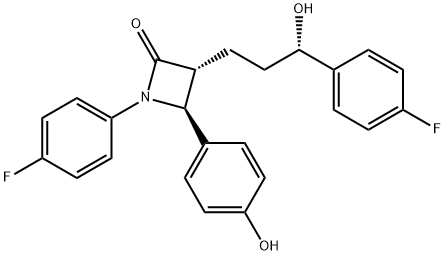Ezetimibe: Mechanisms, Uses, and Proper Storage in Pharmaceutical Practice
Sep 13,2024
Introduction
Ezetimibe is a widely recognized cholesterol-lowering medication that has garnered significant attention in the pharmaceutical and chemical industries. As a member of the class of drugs known as cholesterol absorption inhibitors, Ezetimibe plays a crucial role in managing hypercholesterolemia, a condition characterized by elevated cholesterol levels in the blood.

Figure 1 Characteristics of Ezetimibe
Properties of Ezetimibe
Ezetimibe, chemically known as (3R,4S)-1-(4-fluorophenyl)-3-[(3S)-3-(4-fluorophenyl)-3-hydroxypropyl]-4-(4-hydroxyphenyl)azetidin-2-one, has the molecular formula C24H21F2NO3. It is a white to off-white crystalline powder that is practically insoluble in water but soluble in alcohol and dimethyl sulfoxide (DMSO). The molecular weight of Ezetimibe is 409.43 g/mol, and it has a melting point of approximately 164-166°C.
One of the defining characteristics of Ezetimibe is its ability to selectively inhibit the absorption of cholesterol in the small intestine. This mechanism of action is unique compared to other cholesterol-lowering agents, such as statins, which primarily work by inhibiting cholesterol synthesis in the liver. Ezetimibe's selective inhibition is attributed to its specific interaction with the Niemann-Pick C1-Like 1 (NPC1L1) protein, which plays a key role in the uptake of cholesterol into enterocytes. This inhibition results in a reduction in the overall amount of cholesterol delivered to the liver, leading to a decrease in plasma cholesterol levels.
Composition of Ezetimibe
The active pharmaceutical ingredient (API) in Ezetimibe is Ezetimibe itself, which is responsible for its therapeutic effects. The formulation of Ezetimibe tablets typically includes various excipients that aid in the stability, absorption, and overall efficacy of the drug. Common excipients found in Ezetimibe tablets may include microcrystalline cellulose, lactose monohydrate, povidone, croscarmellose sodium, and magnesium stearate.
Microcrystalline cellulose acts as a binder and filler, providing the necessary bulk and structural integrity to the tablet. Lactose monohydrate serves as a diluent, ensuring that the tablet has the appropriate size and mass for oral administration. Povidone, a synthetic polymer, functions as a binder and helps improve the solubility of the drug. Croscarmellose sodium is a disintegrant that facilitates the rapid breakdown of the tablet in the gastrointestinal tract, allowing for efficient release and absorption of the API. Finally, magnesium stearate is a common lubricant used in tablet formulations to prevent sticking to manufacturing equipment.
Uses of Ezetimibe
Ezetimibe is primarily used in the treatment of hypercholesterolemia, particularly in patients who are unable to achieve adequate cholesterol reduction through diet and lifestyle changes alone. It is often prescribed in combination with statins, such as atorvastatin or simvastatin, to enhance the overall cholesterol-lowering effect. This combination therapy is particularly effective in reducing low-density lipoprotein cholesterol (LDL-C), often referred to as "bad" cholesterol, which is a major risk factor for cardiovascular diseases.
In addition to its use in primary hypercholesterolemia, Ezetimibe is also indicated for the treatment of homozygous familial hypercholesterolemia (HoFH), a genetic disorder characterized by extremely high levels of cholesterol from birth. Patients with HoFH often require aggressive lipid-lowering therapies, and Ezetimibe provides a valuable option in this context.
Furthermore, Ezetimibe has shown potential in reducing cholesterol levels in patients with sitosterolemia, a rare inherited condition where plant sterols, such as sitosterol, accumulate in the blood and tissues. By inhibiting the absorption of both cholesterol and plant sterols, Ezetimibe can help manage this condition effectively.
Storage of Ezetimibe
Proper storage of Ezetimibe is essential to maintain its efficacy and safety. Ezetimibe tablets should be stored at room temperature, typically between 20-25°C (68-77°F), in a dry place away from direct sunlight and moisture. Exposure to excessive heat, light, or humidity can degrade the drug, leading to reduced potency and effectiveness.
It is important to store Ezetimibe in its original packaging to protect it from environmental factors. The packaging is usually designed to provide a barrier against moisture and light, which can negatively impact the stability of the drug. Additionally, Ezetimibe should be kept out of reach of children and pets to prevent accidental ingestion.
For bulk storage in a manufacturing or pharmaceutical setting, Ezetimibe should be stored in airtight containers, preferably made of high-density polyethylene (HDPE) or glass, to prevent contamination and degradation. The storage area should be well-ventilated, with controlled temperature and humidity levels to ensure the long-term stability of the API.
Conclusion
Ezetimibe is a vital medication in the fight against hypercholesterolemia and associated cardiovascular risks. Its unique mechanism of action, which targets cholesterol absorption in the small intestine, sets it apart from other lipid-lowering agents.
[1] Bays, Harold. "Ezetimibe."Expert opinion on investigational drugs11.11 (2002): 1587-1604.
[2] Phan, Binh An P., Thomas D. Dayspring, and Peter P. Toth. "Ezetimibe therapy: mechanism of action and clinical update."Vascular health and risk management(2012): 415-427.
References:
[1] WIERZBICKI A S. Ezetimibe[J]. American Journal of Cardiovascular Drugs, 2012, 3 1. DOI:10.2165/00129784-200303010-00008.
[2] BINH AN P PHAN P P T Thomas D Dayspring. Ezetimibe therapy: mechanism of action and clinical update.[J]. Vascular Health and Risk Management, 2012, 8. DOI:10.2147/VHRM.S33664.
- Related articles
- Related Qustion
- Ezetimibe-Application in hyperlipidemia Jan 9, 2020
Ezetimibe is a new cholesterol absorption inhibitor jointly developed by Schering-Plough and Merck. It was approved by the FDA in October 2002 under the trade name Zetia.
Supplementation with pyridoxal 5'-phosphate monohydrate can synthesize neurotransmitters such as dopamine and serotonin, maintaining a healthy nervous system.....
Nov 4,2025Biochemical EngineeringDCS is a typical example of translational research from neurobiochemical considerations to animal experiments and application in various neuropsychiatric diseases.....
Sep 13,2024Biochemical Engineering








